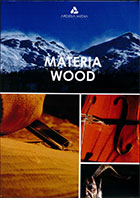
Materia Wood 2015
Distributed by Green Planet Films, PO Box 247, Corte Madera, CA 94976-0247; 415-377-5471
Directed by Paola Castriota
Directed by Paola Castriota
VHS, color and b&w, 55 min., Italian with English subtitles
High School - General Adult
Violin Making, Wood Sculpture, Trees, Musical Instruments
Date Entered: 11/30/2016
Reviewed by Bonnie Jo Dopp, Librarian Emerita, University of MarylandAnyone who has ever wondered where the spruce that is used in making fine Italian string instruments comes from will find an answer in this quiet film that begins in a snowy, carefully conserved Alpine forest (Paneveggio) and reveals the hand preparation of the wood for inspection by violin makers. Good wood is needed in other artistic realms and the film takes us to an art school where students are shown learning to carve wood and make fearsome masks inspired by folk art (depicting the legendary Krampos who lives in the forest). Next, a master luthier patiently scrapes away thin shavings to create a fine cello and explains that each wood is unique. His passion is to learn from every new piece he shapes. The camera lovingly explores gorgeous examples of the fine art of violin making. Various woods from all over the world go into a beautiful violin and even pieces from the same block of wood can have individual voices. Another violin maker finishes an instrument with varnish and speaks of knowing what the wood sounds like by touching it before even beginning to cut it. A visit to the Cremora Museum of Violins closes this segment and we move to a chalet in the mountains for a visit with a modern wood artist who works with the trees around his home. He too confirms that each tree’s wood displays a unique texture and spirit that dictates how it must be worked.
Unobtrusive classical piano or string quartet music is used in the background (uncredited). Problems for library collections include the specialized audiences required to appreciate this program (mainly wood sculptors and their students) and the difficulty English speakers may have with the awkward translation and subtitles (e.g., “value” for “evaluate,” “portion” for “solution,”researches,” “to stole,” “scarings” for “frightening,” and misspellings) that speed by too fast and are sometimes washed out because of white lettering on light or white backgrounds.